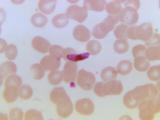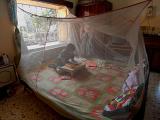The key to eradicating malaria in the near future is stepped up research and development of new tools to battle the disease, a World Health Organization (WHO) expert group that spent the last 3 years studying the malaria landscape said today in a report.
The 13-member group, called the Strategic Advisory Group on Malaria Eradication (SAGme) published a 20-page executive summary of their report, which also includes a set of recommendations, ahead of a WHO-hosted malaria forum in Geneva on Sep 9.
Malaria infections and deaths have held steady since 2015, but there isn't enough progress against the disease to achieve the 2030 goal set out in the latest WHO malaria strategy to cut cases and deaths by 90%, the group said in a press release.
The disease hits children the hardest, with kids under age 5 making up 61% of all malaria deaths. And some of the world's poorest countries are most affected; the WHO said more than 90% of the 400,000 global deaths each year occur in sub-Saharan Africa.
Tedros Adhanom Ghebreyesus, PhD, the WHO's director-general, said in the statement that freeing the world of malaria would be one of public health's greatest achievements. "With new tools and approaches we can make this vision a reality," he added.
Scale-up could have major impact
When the group looked at funding, they found that less than 1% of support for health research and development targets tools to fight malaria.
Marcel Tanner, PhD, MPH, who chairs SAGme and is with the Swiss Tropical and Public Health Institute, said in the statement that there's a need to jump-start the search for transformative strategies and tools that can be tailored to local needs. "Business as usual is not only slowing progress, but it is sending us backwards."
The expert group estimates that scaling up current interventions could prevent 2 billion more malaria cases and 4 million deaths by 2030, but only if they reach 90% of the population in countries that make up 95% of the global burden.
The experts project that the cost of the scale-up would be $34 billion and that the economic gain would be about $283 billion in total gross domestic product—putting the benefit-to-cost ratio above 8:1.
Most tools used to battle the disease were developed in the past century or earlier, the group notes. Promising new efforts are being developed, and the world's first vaccine against malaria—RTS, S/AS01—has been deployed in Ghana and Malawi, with plans for a Kenya rollout.
SAGme pointed to an urgent need to step up research and development and strengthen the pipeline, noting that a research agenda published in 2017 serves as a starting point.
Remaining eradication challenges
A major challenge in many countries is access to health services. For example, the group found that only one in five pregnant women in moderate- to high-transmission parts of Africa can get drugs to protect themselves from malaria. Only half of those at risk for malaria on the continent sleep under insecticide-treated bed nets, and only 3% are protected by indoor insecticide spraying.
As such, among the group's recommendations is to expand universal healthcare coverage and strengthen health services so that more people can access malaria prevention, diagnostics, and treatments.
The WHO said the group's work dovetails with some recent efforts of it and its partners, including the November 2018 launch of a "high burden to high impact" approach that targets 11 countries—10 African countries and India—that have the highest malaria burden.
See also:
Aug 23 WHO SAGme executive summary
Aug 23 WHO press release




















